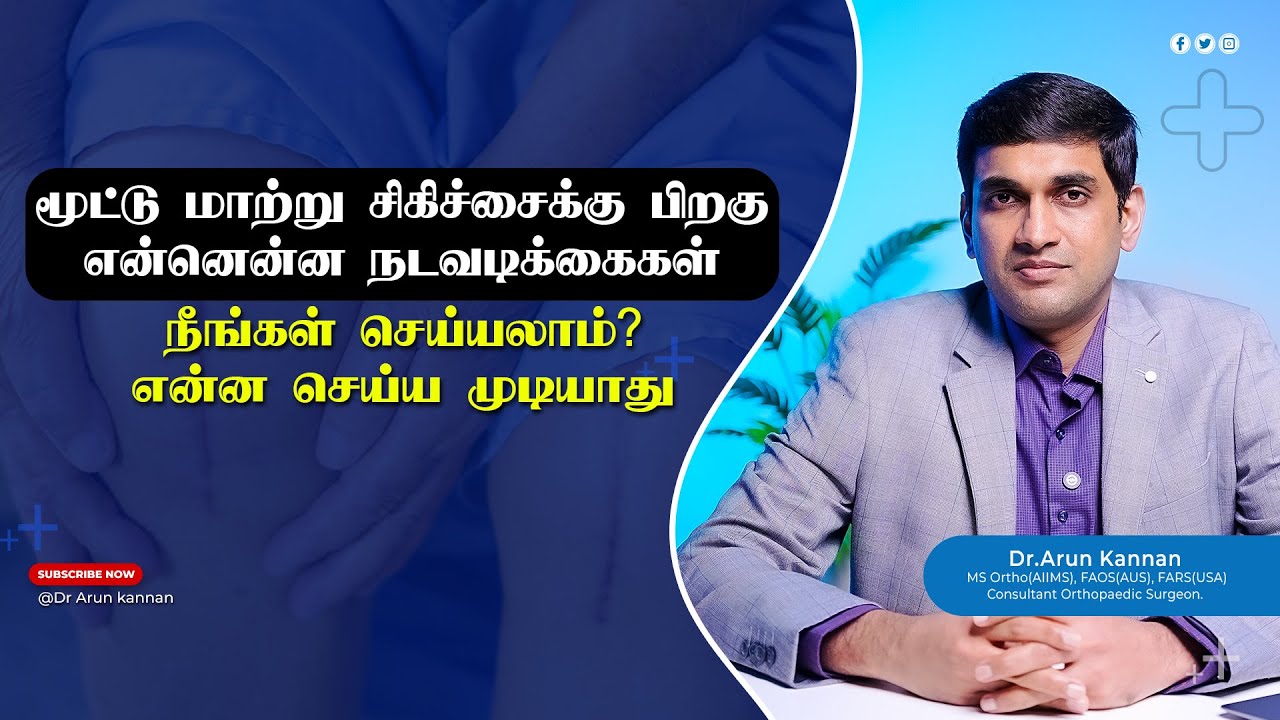 8 July, 2025
8 July, 2025
Best Knee Replacement in Chennai: Dos & Don’ts After Surgery Explained by Dr. Arun Kannan
Knee osteoarthritis or knee joint degeneration is a common problem affecting many, especially in the advanced stages where pain and deformity severely impact daily life. When conservative treatments like medication, physiotherapy, and injections no longer provide relief, knee replacement surgery becomes a highly effective option. If you are considering or have undergone knee replacement surgery, understanding the essential dos and don’ts after the procedure is crucial for a smooth and successful recovery.
Dr. Arun Kannan, a renowned orthopedic surgeon based in Chennai, shares his expert advice on what to expect after knee replacement surgery and how to navigate your recovery phase effectively. This comprehensive guide covers everything from immediate post-operative care to long-term activity recommendations, ensuring you regain mobility safely while protecting your new joint.
Understanding Knee Replacement Surgery and When It’s Needed
Knee replacement, also known as total knee arthroplasty, is typically recommended for patients suffering from severe knee osteoarthritis (OA). Osteoarthritis leads to the gradual wearing out of the cartilage in the knee joint, causing pain, stiffness, and deformity. In mild to moderate cases, conservative measures like medication, physical therapy, and injections can help manage symptoms.
However, when the condition reaches a severe or “severe stage,” characterized by significant cartilage loss, deformity (such as bowing of the leg), and debilitating pain that restricts walking even for 10-15 minutes, knee replacement becomes the best option. At this stage, the surgical replacement of the knee joint with metal and plastic implants can restore function and relieve pain effectively.
Dr. Arun Kannan emphasizes that knee replacement is a long-term solution, not just a quick fix. Understanding what to expect after surgery helps patients set realistic goals and actively participate in their rehabilitation.
Pre-Surgery Preparation: Setting Realistic Expectations
Before undergoing surgery, it is essential to prepare mentally and physically. Dr. Arun Kannan advises patients to have a clear understanding of the recovery process and realistic expectations about the outcomes. This preparation ensures better cooperation during post-operative rehabilitation and helps avoid disappointment.
Patients should discuss the following with their orthopedic surgeon:
- What activities will be possible after surgery?
- What limitations might remain?
- How long will recovery take?
- What rehabilitation exercises are recommended?
Knowing these details enables patients to make informed decisions and commit to their recovery plan effectively.
Immediate Post-Operative Care: What to Expect
Typically, patients are admitted a day before surgery. The surgery itself is usually scheduled early in the morning, and by the next day, patients are encouraged to start weight-bearing on their operated leg using a walker or support frame. This early mobilization is crucial for preventing complications like blood clots and muscle stiffness.
On the first post-operative day:
- Patients are assisted to stand and take a few steps with support.
- Complete bed rest is not necessary beyond the immediate hours after surgery.
- Most patients can sit comfortably in a chair or on the bed with support.
The second day involves more walking exercises, typically within the hospital corridors, to build confidence and strength. Most patients also start sitting on a commode or chair to practice necessary daily activities.
Early Recovery Phase: First Week to One Month
By the third day after surgery, patients often begin stair-climbing training with support. This is important because everyday life involves negotiating steps, and regaining this ability early improves independence.
When discharged home, patients usually continue to use a walker and are encouraged to walk short distances, such as to the bathroom and around the house. This gradual increase in activity promotes circulation, muscle strength, and joint flexibility.
Within one month, most patients can:
- Walk without a walker or support frame for short distances.
- Manage daily household activities including cooking and light chores.
- Experience approximately 50% reduction in pain compared to pre-surgery levels.
Some patients might require a bit longer, up to 6-10 days, to completely wean off walking aids depending on individual strength and comfort.
Intermediate Recovery: Two to Three Months Post-Surgery
Between two and three months after surgery, significant improvements are usually observed:
- Patients can walk outside their homes comfortably without support.
- Stair climbing becomes easier, with many able to climb two or three flights of stairs.
- Most daily activities, including driving and cooking, can be resumed.
- Walking distances typically increase to 2 kilometers or more.
Dr. Arun Kannan notes that about 80% of recovery is achieved by this stage. Patients may still experience some stiffness or heaviness in the knee, but these symptoms gradually improve over the next 3 to 6 months.
Long-Term Recovery and Activity Guidelines: Six to Nine Months and Beyond
By six to nine months, the vast majority of patients have regained near-normal function, with 90-95% recovery compared to pre-arthritis levels. While the knee joint is artificial, it performs very well, allowing most people to enjoy an active lifestyle.
Typical activities recommended during this period include:
- Walking for 30 to 45 minutes daily, including outdoors.
- Climbing stairs comfortably without assistance.
- Engaging in low-impact sports such as swimming and cycling.
- Driving a car confidently.
Patients often return to routine household chores and light gardening or similar tasks. Dr. Arun Kannan stresses that the key is to maintain a balance and avoid high-impact activities that place excessive strain on the knee joint.
Activities to Avoid After Knee Replacement
While knee replacement significantly improves quality of life, certain activities are generally discouraged to preserve the longevity of the implant and avoid complications:
- Squatting or sitting on Indian-style toilets: Deep squatting requires significant knee flexion (bending) beyond 120°, which is not feasible or safe after most knee replacements. Only a minority of patients can perform this without pain or risk.
- Jumping and high-impact exercises: Activities like jumping jacks, running long distances, or intense aerobic workouts can accelerate wear of the plastic components and strain the metal implants.
- Heavy lifting or strenuous sports: Sports requiring sudden twisting or impact on the knee should be avoided.
The goal is to protect the knee joint from undue stress that can lead to early loosening or damage to the prosthesis.
Common Questions About Life After Knee Replacement
Can I walk long distances after surgery?
Yes, most patients can walk 2 kilometers or more comfortably by 6 to 9 months post-surgery. In fact, walking 30 to 45 minutes daily is recommended to maintain joint health and overall fitness.
Is cycling safe after knee replacement?
Cycling is an excellent low-impact exercise that helps restore muscle strength and joint flexibility. Patients can often start gentle cycling as early as 1 month post-surgery and progress to regular cycling by 2 months.
When can I start driving again?
Driving is usually safe to resume by 2 months after surgery, once sufficient muscle strength and knee control are regained.
Can I sit in the squatting position or use Indian toilets?
Deep squatting is generally not recommended after knee replacement due to limited knee bending and risk of implant damage. Patients are advised to avoid Indian-style toilets and opt for Western-style seating where possible.
How long does the knee replacement last?
Modern knee replacements can last 15-20 years or more with proper care. Dr. Arun Kannan points out that about 90-95% of patients experience excellent function and pain relief for at least 20 years.
Will I have pain after surgery?
Some residual pain and stiffness can persist for several months but typically improve with rehabilitation. By 6 to 9 months, most patients have minimal or no pain during daily activities.
Tips for a Successful Recovery After Knee Replacement
- Follow your surgeon’s rehabilitation plan: Regular physiotherapy and exercises are key to regaining strength and mobility.
- Start walking early: Weight-bearing on the operated leg with support the day after surgery helps prevent complications.
- Avoid prolonged bed rest: Moving around reduces stiffness and promotes healing.
- Use walking aids as advised: Gradually transition from walker to cane to independent walking.
- Maintain a healthy weight: Excess weight places extra stress on the knee joint.
- Choose low-impact activities: Swimming, cycling, and walking are excellent options.
- Avoid high-impact or deep bending activities: Protect your new knee from undue wear and tear.
- Be patient: Full recovery can take up to 9 months, and consistent effort yields the best results.
Conclusion
Knee replacement surgery is a transformative procedure that can restore mobility, reduce pain, and improve quality of life for those suffering from severe knee arthritis. However, the surgery is just one part of the journey. Understanding the dos and don’ts after knee replacement is vital to ensuring a smooth recovery and long-lasting results.
Dr. Arun Kannan, an expert orthopedic surgeon in Chennai, highlights that with proper care, rehabilitation, and realistic expectations, most patients achieve 90-95% of their pre-arthritis function within 6 to 9 months. Walking, cycling, swimming, and normal daily activities become possible, while high-impact sports and deep squatting should be avoided to preserve the implant.
If you are looking for the best knee replacement in Chennai, it is essential to choose a skilled surgeon who not only performs the surgery but also guides you through the recovery process with personalized advice tailored to your needs. Remember, knee replacement is a long-term solution, and your active participation in post-operative care is key to success.
Frequently Asked Questions (FAQs)
1. How soon can I start walking after knee replacement surgery?
You can usually start walking with support like a walker or frame the day after surgery under supervision. Early mobilization helps speed up recovery.
2. Can I climb stairs after knee replacement?
Yes, most patients begin stair climbing exercises within the first week post-surgery with support and gradually become independent by 2-3 months.
3. Is it safe to drive after knee replacement?
Driving is generally safe after 6 to 8 weeks once you have regained adequate muscle strength and control.
4. What exercises should I avoid after knee replacement?
Avoid high-impact exercises like running, jumping, and deep squatting. Focus on low-impact activities like walking, cycling, and swimming.
5. How long does pain last after knee replacement?
Initial pain reduces significantly within the first month. Mild discomfort or stiffness may persist up to 6 months but usually resolves with rehabilitation.
6. How long will my knee replacement last?
Modern knee implants typically last 15 to 20 years or longer, depending on activity level and overall health.
7. Can I sit on the floor or use Indian-style toilets after surgery?
Deep squatting is generally not recommended due to limited knee flexion post-surgery. Using Western-style toilets is advisable.
If you have any more questions regarding knee replacement surgery or recovery, feel free to consult with orthopedic specialists or leave your queries for professional guidance. Taking informed steps and following expert advice, like that from Dr. Arun Kannan, can help you enjoy a pain-free and active life after your knee replacement.

